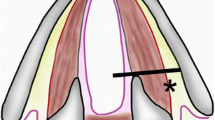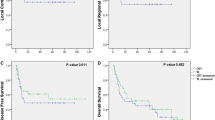Abstract
Chemoradiotherapy is the treatment mostly used as organ preservation (OP) strategy worldwide in advanced laryngo-hypopharyngeal cancer. Due to the not homogeneous results of the literature data regarding the pre-treatment assessment and treatment schedule in this setting of patients, the Italian societies of radiation oncology and medical oncology surveyed (by an online survey) their memberships regarding the Italian attitude on larynx preservation in clinical practice. The survey outline addressed different items such as: demographics (11 items), pre-treatment evaluation (12 items), treatment schedules (10 items) and outcomes (3 items). The survey was filled in by 116 clinical oncologists (64 % radiation and 36 % medical oncologists). Results highlighted that pretreatment evaluation was not homogeneous among the respondents. The treatment of choice for the OP program resulted the concurrent chemoradiotherapy (66 %). Induction chemotherapy was proposed mostly in case of aggressive tumors such as advanced stage (T4 or N3) and/or unfavorable primary sites (hypopharynx). Moreover, after induction chemotherapy, for responders patients most participants (46 %) proposed concurrent chemoradiotherapy, while 18 and 19 % proposed radiotherapy alone or radiotherapy and cetuximab, respectively. For patients with stable disease after induction chemotherapy, the respondents declared to suggest surgery, radiotherapy and cetuximab or radiotherapy alone in 38, 32 and 15 % of cases, respectively. Results of the present survey highlighted the variability of therapeutic approaches offered in clinical practice for patients candidate to a larynx OP program. Analysis of abovementioned results may give the chance to modify some clinical attitudes and create the background for future clinical investigation in this field.





Similar content being viewed by others
References
Denaro N, Russi EG, Lefebvre JL, et al. Systematic review of current and emerging approaches in the field of larynx preservation. Radiother Oncol. 2014;110:16–24.
Forastiere A, Weber RS, Trotti A. Organ preservation for advanced larynx cancer: issues and outcome. J Clin Oncol. 2015;33:3262–8.
Lefebvre J-L, Ang KK. Larynx preservation clinical trial design: key issues and recommendations—a consensus panel summary. Head Neck. 2009;31:429–41.
Bradford CR, Wolf GT, Carey TE, et al. Predictive markers for response to chemotherapy, organ preservation, and survival in patients with advanced laryngeal carcinoma. Otolaryngol Head Neck Surg. 1999;121:534–8.
Forastiere AA, Goepfert H, Maor M, et al. Concurrent chemotherapy and radiotherapy for organ preservation in advanced laryngeal cancer. N Engl J Med. 2003;349:2091–8.
Rosenthal DI, Mohamed ASR, Weber RS. Long term outcome after surgical or non-surgical initial therapy in patients with T4 squamous cell carcinoma of the larynx; a 3-decade survey. Cancer. 2015;15:1608–19.
Bussu F, Paludetti G, Almadori G, et al. Comparison of total laryngectomy with surgical (cricohyoidopexy) and non-surgical organ-preservation modalities in advanced laryngeal squamous cell carcinoma; a multicenter retrospective analysis. Head Neck. 2013;35:554–79.
Worden FP, Moyer J, Lee JS. Chemoselection as a strategy for organ preservation in patients with T4 laryngeal squamous cell carcinoma with cartilage invasion. Laryngoscope. 2009;119:1510–7.
Wagner MM, Curé JK, Caudell JJ. Prognostic significance of thyroid or cricoidcartilage invasion in laryngeal or hypopharyngeal cancer treated with organ preserving strategies. Radiat Oncol. 2012;. doi:10.1186/1748-717X-7-219.
Mucha-Małecka A, Składowski K. High-dose radiotherapy alone for patients with T4-stage laryngeal cancer. Strahlenther Onkol. 2013;189:632–8.
The Department of Veterans Affairs Laryngeal Cancer Study Group. Induction chemotherapy plus radiation in patients with advanced laryngeal cancer. N Eng J Med. 1991;324:1685–90.
MacKenzie R, Frassen E, Balogh J, et al. The prognostic significance of tracheostomy in carcinoma of the larynx treated with radiotherapy and surgery for salvage. Int J Radiat Oncol Biol Phys. 1998;41:43–51.
Richard JM, Sancho-Garnier H, Pessey JJ, et al. Randomized trial of induction chemotherapy in larynx carcinoma. Oral Oncol. 1998;34:224–8.
Lefebvre J-L, Ang KK. On behalf of the larynx preservation consensus panel Larynx preservation clinical trial design; key issue and recommendations-a consensus panel summary. Int J Radiat Oncol Biol Phys. 2009;73:1293–303.
AIOCC guidelines http://www.aiocc.it/contents/attached/c17/Linee_guida_Aiocc_-_AIRO-_AIOM_maggio_2012.pdf.
AIOM guidelines http://www.aiom.it/area+pubblica/area+medica/prodotti+scientifici/linee+guida/1%2C333%2C1%2C.
NCCN guidelines http://www.nccn.org/professionals/physician_gls/f_guidelines.asp.
Pignon J-P, le Maitre A, Maillard E, et al. Meta-analysis of chemotherapy in head and neck cancer (MACH-NC): an update on 93 randomised trials and 17,346 patients. Radiother Oncol. 2009;92:4–14.
Schindler A, Denaro N, Russi EG. Dysphagia in head and neck cancer patients treated with radiotherapy and systemic therapies: literature review and consensus. Crit Rev Oncol Hematol. 2015;96:372–84.
Lagha A, Chraiet N, Labidi S, et al. Larynx preservation: what is the best non-surgical strategy? Crit Rev Oncol Hematol. 2013;88:447–58.
Forastiere AA, Zhang Q, Weber RS, et al. Long-term results of RTOG 91-11: a comparison of three nonsurgical treatment strategies to preserve the larynx in patients with locally advanced larynx cancer. J Clin Oncol. 2013;31:845–52.
Lefebvre J-L, Rolland F, Tesselaar M, et al. Phase 3 randomized trial on larynx preservation comparing sequential versus alternating chemotherapy and radiotherapy. J Natl Cancer Inst. 2009;101:142–52.
Lefebvre JL, Chevalier D, Luboinski B, et al. Larynx preservation in pyriform sinus cancer: preliminary results of a European Organization for Research and Treatment of Cancer phase III trial. EORTC Head and Neck Cooperative Group. J Nat Cancer Inst. 1996;88:890–9.
Lefebvre JL, Andry G, Chevalier D, et al. Laryngeal preservation with induction chemotherapy for hypopharyngeal squamous cell carinoma: 10-year results of EORTC trial 24891. Ann Oncol. 2012;23:2708–14.
Pointreau Y, Garaud P, Chapet S, et al. Randomized trial of induction chemotherapy with cisplatin and 5-fluorouracil with or without docetaxel for larynx preservation. Natl Cancer Inst. 2009;101:498–506.
Posner MR, Norris CM, Wirth LJ, et al. Sequential therapy for the locally advanced larynx and hypopharynx cancer subgroup in TAX 324: survival, surgery, and organ preservation. Ann Oncol. 2009;20:921–7.
Bonner JA, Harari PM, Giralt J, et al. Radiotherapy plus cetuximab for squamous-cell carcinoma of the head and neck. N Engl J Med. 2006;354:567–78.
Lefebvre JL, Pointreau Y, Rolland F, et al. Induction chemotherapy followed by either chemoradiotherapy or bioradiotherapy for larynx preservation: the TREMPLIN randomized phase II study. J Clin Oncol. 2013;31:853–9.
Author information
Authors and Affiliations
Corresponding author
Ethics declarations
Conflict of interest
None.
Electronic supplementary material
Below is the link to the electronic supplementary material.
Rights and permissions
About this article
Cite this article
Alterio, D., Franco, P., Numico, G. et al. Non-surgical organ preservation strategies for locally advanced laryngeal tumors: what is the Italian attitude? Results of a national survey on behalf of AIRO and AIOM. Med Oncol 33, 76 (2016). https://doi.org/10.1007/s12032-016-0781-5
Received:
Accepted:
Published:
DOI: https://doi.org/10.1007/s12032-016-0781-5




